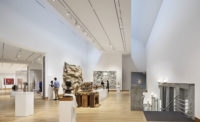 |
| Photo © David Hathcox Photography |
Amanda Burden, the NYC planning commissioner, was one of 15 speakers at the 22nd annual Accent on Architecture Gala in Washington, D.C. She received the Keystone Award. |
On February 4, more than 400 architects, planners, developers, and journalists attended the 22nd annual Accent on Architecture Gala in Washington, D.C. The black-tie dinner hosted by the American Architectural Foundation (AAF) will likely be remembered as a night of impressive grandiloquence. On the program were representatives from government, the private sector, the AIA, and the AAF. The 15 speakers included Rocco Landesman, chairman of the National Endowment for the Arts; G. Sandy Diehl III, vice president of Integrated Building Solutions, UTC; Paul Goldberger, architecture critic of the New Yorker; and Joel Rose, CEO of School of One.
New York City planning commissioner Amanda Burden received the Keystone Award. Bestowed each year by the AAF, the award honors those outside the architectural discipline who have helped improve architecture and planning through their leadership. Upon stepping onto the stage, Burden, who spoke last, acknowledged that the evening’s presentations had run over time and gracefully put aside her notes. She simply thanked a few people important to her efforts, including her mentor, William H. Whyte, the late urban critic and sociologist. Her succinct comments underscored why Burden has successfully spearheaded New York City planning efforts since her tenure began in 2002. During this time she helped realize the highly successful High Line Park (2009) by creating zoning that facilitated air-rights transfers to developers. Currently, she is undertaking the rezoning of the New York City waterfront, such as the East River Esplanade in Lower Manhattan.
During the evening, the AAF also recognized Chicago mayor Richard M. Daley, who was unable to attend the gala. Daley received the first Joseph P. Riley Jr. Award for Leadership in Urban Design. The dinner, which followed the AIA’s three-day Grassroots conference, was held in the Andrew W. Mellon Auditorium (designed by Arthur Brown Jr. in 1931). The inspired choice of venue allowed those in the audience to soak up the august, classical architecture.




